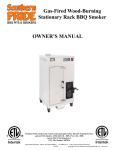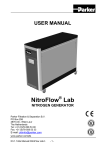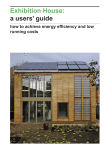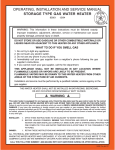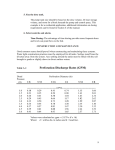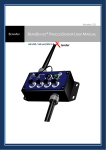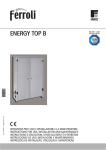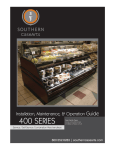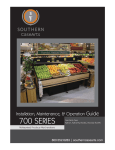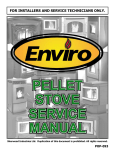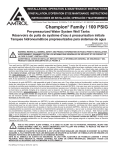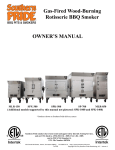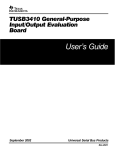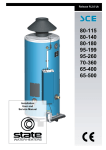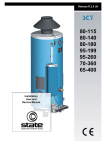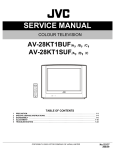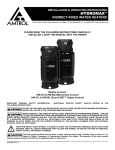Download Manual - American Standard Water Heaters
Transcript
181414 R ev. 02 A ugust - 2010 Operating, installation and service manual AMERICAN STANDARD WATER HEATERS HIGH EFFICIENCY MODELS: HE70-125, HE100-150, HE100-199 & HE100-250 REQUIRES 120 V A.C. POWER SUPPLY American Standard Water Heaters http://www.waterheating.com WARNING: If the information in these instructions is not followed exactly a "re or explosion may result causing property damage, personal injury or death. -DO NOT store or use gasoline or other #ammable vapors and liquids in the vicinity of this or any other appliance. WHAT TO DO IF YOU SMELL GAS CAUTION THIS WATER HEATER SHOULD NOT BE USED TO HEAT A SPA OR HOT TUB - DO NOT try to light any appliance. - DO NOT touch any electric switch; do not use any phone in your building. - IMMEDIATELY call your gas supplier from a neighbor’s phone, follow the gas supplier’s instructions. - If you cannot reach your gas supplier, call the "re department. - Installation and service must be performed by$% "ed installer, service agency or the gas supplier. WARNING: This water heater is equipped for one type of gas only. Check the data plate near the gas control valve for the correct gas. DO NOT USE THIS WATER HEATER WITH ANY GAS OTHER THAN THE ONE LISTED ON THE DATA PLATE. Failure to use the correct gas can cause problems which can result in DEATH, SERIOUS BODILY INJURY OR PROPERTY DAMAGE. If you have any questions or doubts consult your gas supplier or gas company. Water heaters for bottled, propane or $%"ed petroleum gas (LPG) are different from natural gas models. A natural gas heater will not function safely on bottled, propane or $%"ed petroleum gas (LPG) and no attempt should be made to convert a heater from natural gas to any other gas. INSTALLER: 1. AFFIX THESE INSTRUCTIONS TO OR ADJACENT TO WATER HEATER. 2. BEFORE LEAVING PREMISES: REVIEW THIS OPERATION AND SERVICE MANUAL TO BE SURE HEATER HAS BEEN INSTALLED CORRECTLY. MAKE SURE UNIT IS STARTED AND OPERATED FOR ONE COMPLETE CYCLE AND WATER TEMPERATURE IS ACCEPTABLE TO THE CONSUMER AT THE FIXTURES. OWNER: 1. RETAIN THESE INSTRUCTIONS AND WARRANTY FOR FUTURE REFERENCE. IF YOU HAVE QUESTIONS THAT ARE NOT ANSWERED IN THE MANUAL YOU MAY CALL THE TOLL FREE NUMBER 800 900-9063 OR CONTACT US BY EMAIL AT: [email protected]. DO NOT CONTACT US BY TELEPHONE OR EMAIL FOR WARRANTY REGISTRATION. YOUR WATER HEATER SERIAL NUMBER IS ALREADY ON FILE. THE WARRANTY IS ACTIVATED AT THE TIME OF PURCHASE. KEEP YOUR RECEIPT TO SHOW TO SERVICE PERSON IF SERVICE IS REQUIRED. 3 GENERAL SAFETY NOTICE TO INSTALLERS & USERS. BE AWARE OF THE FOLLOWING DANGERS ASSOCIATED WITH THE INSTALLATION AND USAGE OF GAS WATER HEATERS: Read and understand instruction manual and safety messages before installing, operating or servicing this water heater. Failure to follow instructions and safety messages could result in death or serious injury. Instruction manual must remain with water heater. For continued protection against risk of fire: Do not install water heater on carpeted floor. Do not operate water heater if flood damaged. The California Safe Drinking Water and Toxic Enforcement Act requires the Governor of California to publish a list of substances known to the State of California to cause cancer, birth defects, or other reproductive harm, and requires businesses to warn of potential exposure to such substances. WARNING: This product contains a chemical known to the State of California to cause cancer, birth defects, or other reproductive harm. This appliance can cause low-level exposure to some of the substances listed, including formaldehyde, carbon monoxide, and soot. AIR REQUIREMENTS: KEEP APPLIANCE AREA CLEAR AND FREE OF COMBUSTIBLE MATERIALS, GASOLINE AND OTHER FLAMMABLE VAPORS AND LIQUIDS. DO NOT OBSTRUCT THE FLOW OF COMBUSTION AND VENTILATING AIR. WARNING: FOR SAFE OPERATION, PROVIDE Water temperature over 125ºF (52ºC) can cause severe burns instantly resulting in severe injury or death. Children, the elderly, and the physically or mentally disabled are at highest risk for scald injury. Feel water before bathing or showering. Temperature limiting valves are available. Read instruction manual for safe temperature setting. Overheated water can cause water tank explosion. Properly sized temperature and pressure relief valve must be installed in opening provided. ADEQUATE AIR FOR COMBUSTION AND VENTILATION. AN INSUFFICIENT SUPPLY OF AIR WILL CAUSE RECIRCULATION OF COMBUSTION PRODUCTS RESULTING IN CONTAMINATION THAT MAY BE HAZARDOUS TO LIFE. SUCH A CONDITION COULD AFFECT BURNER FLAME, CAUSING CARBONING OR SOOTING OF THE COMBUSTION CHAMBER, BURNERS AND FLUE TUBES AND CREATES A RISK OF ASPHYXIATION. MECHANICAL EXHAUSTING OF ROOM AIR: WHERE AN EXHAUST FAN IS INSTALLED IN THE SAME ROOM WITH A HEATER, SUFFICIENT OPENINGS FOR AIR MUST BE PROVIDED IN THE WALLS. UNDERSIZED OPENINGS WILL CAUSE AIR TO BE DRAWN INTO THE ROOM THROUGH THE HEATER’S VENTING SYSTEM, CAUSING POOR COMBUSTION. SOOTING MAY RESULT IN SERIOUS DAMAGE TO THE HEATER AND RISK OF FIRE OR EXPLOSION. IT CAN ALSO CREATE A RISK OF ASPHYXIATION. WARRANTY LIMITATIONS TABLE OF Contents Please complete the following information at the time of installation, retain and present along with the warranty in the event that a claim is necessary. MODEL NUMBER______________________ TYPE OF GAS_________ SERIAL NUMBER __________________________________ INSTALLATION ADDRESS:___________________________ ________________________________________________ ________________________________________________ DATE OF INSTALLATION:____________________________ THIS WATER HEATER HAS BEEN INSTALLED IN ACCORDANCE WITH THESE INSTALLATION INSTRUCTIONS AND LOCAL CODE REQUIREMENTS INSTALLER _____________________________________ THE MANUFACTURER OF THIS WATER HEATER WILL NOT BE RESPONSIBLE FOR TANK FAILURES OR WATER HEATER FAILURES RESULTING FROM ANY OF THE FOLLOWING. CONDITIONS AND MAY AT IT'S DISCRETION VOID THE WATER HEATER WARRANTY WHEN THESE CONDITIONS RESULT IN PREMATURE FAILURES OF THE TANK OR COMPONENTS... 1. INSTALLATIONS NOT COMPLYING WITH ALL LOCAL CODES. 2. FAILURES DUE TO UNDERSIZING OF THE WATER HEATER AND SUBSEQUENT EXCESSIVE BURNER FIRING. 3. BAD WATER CONDITIONS SUCH AS WELL WATER WITH EXCESSIVE MINERAL DEPOSITS. IT IS THE RESPONSIBILITY OF THE INSTALLER TO TAKE WHAT EVER STEPS ARE REQUIRED, INCLUDING THE INSTALLATION OF WATER SOFTENERS, TO PREVENT EXCESSIVE LIME BUILD UP AND SUBSEQUENT METAL FATIGUE DUE TO OVER HEATING OF THE TANK BOTTOM. 4. FAILURE TO USE THE HAND HOLE CLEANOUT PROVIDED IN THIS WATER HEATER TO KEEP LIME DEPOSITS IN THE TANK BOTTOM FROM EXCEEDING 2" IN HEIGHT. 5. INSTALLATION OF MULTIPLE HEATERS IN LINE RATHER THAN PARALLEL PER THE INSTRUCTIONS PROVIDED ON PAGES 9 AND 10 OF THIS MANUAL RESULTING IN EXCESS FIRING AND/OR EXCESSIVE CONDENSATION OF ONE OR MORE OF THE HEATERS. 6. FAILURE OF THE HEATER OR COMPONENTS AS A RESULT OF IMPROPER VENTING RESULTING IN NEGATIVE AIR PRESSURE DUE TO IMPROPER LOCATION OR OVERHEAD FANS. 7. FAILURE OF THE HEATER OR COMPONENTS CAUSED BY CHEMICALS OR SOLVENTS BEING STORED IN THE IMMEDIATE VICINITY OF THE WATER HEATER. WARNING: IMPROPER INSTALLATION, ADJUSTMENT, ALTERATION, SERVICE OR MAINTENANCE CAN CAUSE INJURY, DEATH OR PROPERTY DAMAGE. READ AND REFER TO THIS MANUAL. THIS WATER HEATER MUST BE PROPERLY AND REGULARY MAINTAINED. FAILURE TO DO SO WILL VOID THE WARRANTY. 1 CONSUMER RESPONSIBILITIES WARNING THIS MANUAL HAS BEEN PREPARED TO ACQUAINT YOU WITH THE INSTALLATION, OPERATION AND MAINTENANCE OF YOUR GAS WATER HEATER AND TO PROVIDE IMPORTANT SAFETY INFORMATION. WE URGE YOU TO READ ALL INSTRUCTIONS THOROUGHLY BEFORE ATTEMPTING INSTALLATION OR OPERATION OF YOUR WATER HEATER. KEEP THESE INSTRUCTIONS FOR FUTURE REFERENCE. The manufacturer of this water heater will not be liable for any damages caused by failure to comply with the installation and operating instructions outlined on the following pages. These instructions are a guide for the correct installation of your water heater. If you lack the necessary skills required or have difficulty following the directions, you should not proceed but get help from a qualified person for that part of the installation you do not understand. Failure to follow this warning can result in an incorrect installation that can result in DEATH, INJURY OR PROPERTY DAMAGE. This water heater is design-certified by CSA International as both a direct vent and a non-direct vented water heater, which takes its combustion air, either from the installation area or from air ducted to the unit from the outside. Important WARNINGS DO NOT use this appliance if any part has been under water. Immediately call a qualified service technician. Water heaters subjected to flood conditions, or anytime the gas controls, main burner or pilot have been submerged in water, require replacement of the entire water heater. UNPACKING THE WATER HEATER Use two or more people to move and install water heater, unless proper handling equipment is utilized. Failure to do so can result in back or other injury. Important: DO NOT REMOVE any permanent instructions, labels, or the data label from outside of the water heater or on the inside of panels. Remove exterior packaging and place installation components aside. Inspect all parts for damage prior to installation and startup. Completely read all instructions before attempting to assemble and install this product. When referring to your water heater always have the information listed on the rating plate readily available. LOCATION Important: The water heater should be located in an area where leakage of WARNING Location selection should be as close to the stack or chimney as practical and as centralized with the piping system as possible. Water heater should be located in an area not subject to freezing temperatures. The water heater should be located so that the controls and drain are easily accessible (at least 24 inches in front of the water heater). the tank or connections will not result in damage to the area adjacent to the water heater or to lower floors of the structure. Due to the normal corrosive action of the water, the tank will eventually leak after an extended period of time. Also, any external plumbing leak, including those from improper installation, may cause early failure of the water tank due to corrosion if not repaired. A qualified service technician should be contacted for repairs. A suitable metal drain pan should be installed under the water heater as shown below (Figure 1), to help protect the property from damage which may occur from condensate formation or leaks in the piping connections or tank. The pan must limit the water level to a maximum depth of 1 3/4 “ and be at least two inches wider than the heater and piped to an adequate drain. Locate the water heater near a suitable indoor drain. Outside drains are subject to freezing temperatures which can obstruct the drain line. The piping should be at least 3/4” ID and pitched for proper drainage. Under no circumstances will the manufacturer or seller of this water heater be held liable for any water damage which is caused by your failure to follow these instructions. 2 Figure 1. Metal Drain Pan Piped to adequate drain. 1.75 MAX. FIRE AND EXPLOSION HAZARD Can result in serious injury or death Do not store or use gasoline or flammable vapors and liquids in the vicinity of this or any other appliance. Storage of or use of gasoline or other flammable vapors or liquids in the vicinity of this or any other appliance can result in serious injury or death. At least two inches greater than the largest diameter of the water heater.. LOCATION REQUIREMENTS If installed in a garage, avoid damage to your water heater by installing a vehicle stop as shown in figure 2. Check state and local codes for requirements prior to installation. This water heater is not certified for installation in mobile homes. Figure 2.Vehicle Stop in Garage GARAGE NOTE: In the State of California, the water heater must be braced, anchored, or strapped to avoid moving during an earthquake. Contact local utilities for code requirements in your area or call 1-800-456-9805 and request instructions. The water heater must be installed indoors and in a vertical position on a level surface. DO NOT install in bathrooms, bedrooms, or any occupied room normally kept closed. NOTE: The water heater may be installed in a closet with a door, other than a bedroom or bathroom, providing the units are installed and vented per the manufacturer’s instructions. The venting system must comply with the requirements set forth in the venting section of this manual. Important: Air for combustion and ventilation must not come from a corrosive atmosphere. Any failure due to corrosive elements in the atmosphere is excluded from warranty coverage. VEHICLE STOP DRAIN NOTE: This water heater must be installed according to all local and state codes; Or, in the absence of local and state codes; the “National Fuel Gas Code”, ANSI Z223 .1 (NFPA 54)-Latest edition. This publication is available from the following: American Gas Association Orders telephone No: (Toll Free) 866.816.9444 National Fire Protection Agency. 1 Batterymarch Park. Quincy, MA 02269. Check your local phone listings for the local authorities having jurisdiction over your installation. ''!()*()*()()*+,-/(*"0"'0 ! " # --4 "-0 - '!() - -5- -(0 ()-6 - 75*- - -84 -0 !9 - !0() &!'&# * !#" " '#"+ *#" # "+ #" #" &#''&#' !!"+ !#" !##" +#"+ *#" + +"+ #" !'#" &#''&#** &#''&' !!"+ !#" !##" +#"+ *#" + +"+ #" !!"+ !#" !##" +#"+ *#" + +"+ &#''&'&% !!"+ !#" !'#" +#"+ *#" + +"+ % $ - :-0 #*()'- )) #* )) -84 )) 407 *4:#- %& ##"$ #"$ " *' %& ##"$ #"$ " *' !'#" %& ##"$ #"$ " *' #" !'#" ##"$ %& #"$ # *' #" !'#" ##"$ %& #"$ # *' C A " " ! 4 Breathing Hazard - Carbon Monoxide Gas Install Vent system in accordance with codes. Do not operate water heater if flood damaged. Do not operate if soot build up is present. Do not obstruct water heater air intake with insulating jacket. Do not place chemical Vapor emitting products near water heater. WARNING: If replacing an existing water heater, the venting system must be reviewed to be certain it complies with the requirements in this manual. Gas and Carbon monoxide detectors are available. Breathing carbon monoxide can cause brain damage or death. Always read and understand instruction manual. INSTALLATION CHECK LIST This is presented for ease of reference. It is not comprehensive. All instructions and warnings must be read and adhered to. WATER HEATER LOCATION REQUIREMENTS Proper clearance from combustible surfaces observed and heater not installed directly on carpeted floor. Sufficient room to service the water heater. Provisions made to protect area from water damage. Properly sized drain pan installed and piped to an adequate drain. Installation area free of corrosive elements and flammable vapors or materials. Sufficient fresh air supply for proper operation of heater. Keep vent inlets and outlets free of obstructions. VENT TERMINATION Correct relationship- outlet to inlet. 12” Min. above grade/snow level. 2” exhaust outlet/air inlet pipe sloped down towards water heater at 1/4” per foot. 3” piping sloped down towards the heater at 1/8” per foot. Away from corners, other vents, windows, etc. CONDENSATE LINE VERTICAL VENT TERMINATION - SINGLE TUBE Drain stem is fully inserted in the elbow and glued properly. Trap aligned so that the exhaust pipe is in a vertical position close to the surface of the water heater. Properly sloped to adequate drain or approved pump. Protected from freezing if required. VENT PIPE SYSTEM Vent pipe and fittings of approved material. Acceptable size, length, and number of elbows on air inlet pipe. Installed in accordance with the prevailing provisions of Local codes, or in the absence of such, National Fuel Gas Code, NFPA 54, ANSI Z223. Not obstructed in any way. ALTERNATE HORIZONTAL VENT TERMINATION Correct relationship - outlet to inlet. 12” Min. above anticipated snow level. Away from corners, other vents, windows, etc. Inlet -12” Min. above grade/snow level. Correct relationship - outlet to inlet. Away from corners, other vents, windows, etc. CONCENTRIC VENT 12” Min. above grade/snow level. Away from corners, other vents, windows, etc. WATER SYSTEM PIPING Temperature and pressure relief valve opening facing downward with a discharge line run to an open drain and protected from freezing. All piping properly installed and free of leaks. Heater completely filled with water. 5 A properly sized expansion tank must be installed on all closed systems. Tempering valve properly installed per manufacturer’s instructions- if desired. GAS SUPPLY AND PIPING Adequate size for BTU input. Gas supply is the same type as listed on the water heater data plate. Gas line equipped with full opening shut-off valve, union and drip leg. Approved pipe joint compound used. WATER Chloride-free soap and water solution or other approved means used to check all connections and fittings for possible gas leaks. ELECTRICAL CONNECTIONS Unit connected to a dedicated power supply. Unit connected to a 120V electrical supply. Proper Polarity. Water heater properly grounded. The appliance when installed must be electrically grounded in accordance with local codes or in the absence of local codes with the National Electrical code, ANSI/N FPA-70. Installed in accordance with prevailing provisions of local codes, or in the absence of such, National Fuel Gas Code, NFPA 54, ANSI Z223. PIPING Pipes and fittings should be installed in compliance with the installation piping PAGE 9. Check for proper fitting in cold water connection before connecting of hot and cold water lines. If the indoor installation area is subject to freezing temperatures, water piping must be protected. The water heater should be drained from tank and lines if being shut down during freezing temperatures. If sweat connections are used, sweat tubing to the adaptor before fitting adaptor to the cold and hot water fittings. It is imperative that no heat be applied to the water heater fittings as they may contain nonmetallic parts. WARNING: OPERATING AN EMPTY OR PARTIALLY FILLED WATER HEATER WILL RESULT IN DAMAGE TO THE TANK Install the water piping and fittings as shown on PAGE 9. 1. Connect the cold water supply (3/4” NPT) to the bottom fitting marked “C”. Connect the hot water supply (3/4” NPT) to the fitting marked “H” located on top of the unit. Important: Some models may contain energy saving heat traps to prevent the circulation of hot water within the pipes. Do not remove the inserts within the heat traps. 2. The installation of unions in both the hot and cold water supply lines is recommended for ease of removing the water heater for service or replacement. 3. The manufacturer of this water heater recommends installing a tempering valve or anti-scald device for a domestic hot water line. These valves reduce the point-of-use temperature of the water by mixing cold and hot water and are readily available for use. 4. Install a shut-off valve in the cold water inlet line. It should be located close to the water heater and be easily accessible. Know the location of this valve and how to shut off the water to the heater. 5. A temperature and pressure relief valve is installed in the opening marked “Temperature and Pressure (T & P) Relief Valve” on the water heater. 6. Add a discharge line to the opening of the T & P Prelief valve. Follow the instructions under “Temperature and Pressure Relief Valve”. 7. After piping has been properly connected to the water heater, open the nearest hot water faucet. Open the hot water faucet and allow the tank to completely fill with water. To purge the lines of any excess air, keep the hot water faucet open for 3 minutes after a constant flow of water is obtained. Close the faucet and check all connections for leaks. Water supply pressure should not exceed 80% of the working pressure of the water heater. The working pressure is stated on the water heater’s data plate. If this occurs a pressure reducing valve with a bypass should be installed in the cold water inlet line to the entire system. This should be placed on the supply to the entire structure in order to maintain equal hot and cold pressures. = > ?@ >J[\]^_J`{[|}{``~J]|]`J[{[`J[{JJ| [J{[J{J[ [J[J|]\_\[\`{\] \]]J\[\}J[\]\J[\] [J{J[ }{J]\_\[\`{\]\]]J\ [\ }J[\] \J[\] { ]\ \[ { { ^_J[{[{\ {`_\ [ \ }{ []{_[\ [ J]\ { `~\ {\]J` _ J {_ J`{_ J J\ {_ `_ `]{\ J _`J[\ {[{J``|}J[\][J[{ [J{{]J { \J _]\ J J ]\_\ [\ `{\ [\ }J[\] \J[\] >J[\][]\J[\[ | [\ _J }J[\] [\\] ] J]\\] J\_ \[J{[J{}J[\]^_J`{[| % #%_ [[\ J``\][J[\{\ {\[\]\`{\ ~J`~\ %_ [[\`_\]`\ %_ [\J[\]{J`JJ`\}{[ [J{#' }{[_[{ [][{ %_ [\{ [J``\ J [J``}`\[\]J{J\ [[\[\\]J[_]\J]\ _]\]\`{\~J`~\ J{ J]\`{\ %_ [[\]{J[\J[JJ\^_J[\]J{ %_ [[J~\J|~J`~\\[}\\[\]\`{\~J`~\ J[\\J[\] J{`_]\[J{[J{[\]\]`|`{ [\[\\]J[_]\J ]\ _]\]\`{\~J`~\}{``]\`\J \[\J_J[_]\]] J|`J{ }{{[]\ _`[]\\ {~\[\\]J[_]\ ]}J[\]]\ _]\ ]][\[{JJ{ [\\ {~\]\ _]\ J"] [\\]J[_]\ J[\\]J[_]\J]\ _]\]\`{\~J`~\{ { [J``\{[\\{J]\[\\]J[_]\J ]\ _]\ ]\`{\ ~J`~\$ \ { \][{\ | J J[{J``| ]\{\[\ [{`J]J[]|[J[J{[J{ \]{{ { \[{]_[{`{ [\\^_{\[]J[\]{J` J \\[{[\]\^_{]\\[ ]\`{\J`~\ J _[J[{J _[& \~{\ ][>J[\]_`| | [\ #{ _]{ \}{[[{ }J[\]\J[\] []\J J ] `_ [\ \ [{ { J]\ `{\\\][J{[J[[J[{ J\}{[J|`{~\ \`\[]{J`J][ \[{ J]\`{\{]\[`|[]J{* ]\~\[{`|{_]|JJ][`{\]JJ\[ ]\][|[\]\`{\~J`~\_ [\J``}\[{ J]\ }J[\]{[\\~\[\\ {~\[\\]J[_]\]]\ _]\ \~\`{{[\}J[\]\J[\] \_[{[\[\\]J[_]\J]\ _]\]\`{\ ~J`~\{ [{ J]\}J[\]{`J]\^_J[{[{\ _`{]& _ [J\ \J[\{ J]\{\{ [{]\[\ [[\]J{J }*][\] _{[J`\ \J [\}J[\]}J|J_ \]\][|JJ\ {_]\ >[J[[\[[\]& J[\[{ }J[\]\J[\]}{[`}J[\]{`\[~J`~\` \ %J_J``| \]J[\ [\ [\\]J[_]\ J ]\ _]\ ]\`{\ ~J`~\J[`\J [\J|\J]{_]\]\~\[}J[\] JJ\ { J]\ `{\ _ [ [\]{J[\ J[ J J\^_J[\ ]J{*[J{`\J][\_[`\[{ J]\ }J[\]J|\[`{[J]\`\J \[\`\~\]J`\[\ 7 temperature and pressure relief valve to make the valve operate freely. If the heater is installed in a closed system, the temperature and pressure relief valve may drip at times. If the temperature and pressure relief valve discharges a full stream of water, have the system checked. See “Pressure Build-Up in Water System” (Page 6). If the temperature and pressure relief valve on the appliance discharges periodically, this may be due to thermal expansion in a closed water supply system (see “Pressure Build-Up in Water System”). Contact the water supplier or local plumbing inspector on how to correct this situation. Do not plug the temperature and pressure relief valve. TEMPERING VALVE INSTALLATION It is recommended that a tempering valve be installed, per the manufacturer’s instructions, for water heaters supplying domestic hot water (See PAGE 8 for a sample tempering valve installation). GENERAL INFORMATION Water piping, ttings, and valves must be properly installed for the correct and safe operation of this water heater. Please note the following: The system should be installed only with piping that is suitable for potable (drinking) water such as copper, CPVC, or polybutylene. PVC water piping may be used on the cold water inlet supply but not within 18 inches of the cold water connection on the water heater. DO NOT use PVC piping on the hot water outlet, space heating supply, or space heating return. DO NOT use any pumps, valves, or ttings that are not compatible with potable water. DO NOT use valves that may cause excessive restriction to water ow. Use full ow ball or gate valves only. DO NOT use 50/50 tin-lead solder (or any lead based solder) in potable water lines. Use 95/5 solder or other equivalent material. DO NOT tamper with the thermostat, gas valve, blower, electrical components, or temperature and pressure relief valve. Tampering with any of the components is dangerous and can result in death, severe injury, or property damage. Tampering voids all warranties. `|^_J`{ed technicians should service these components. DO NOT use this water heater as a replacement for an existing boiler installation. DO NOT use with piping that has been treated with chromates, boiler seal, or other chemicals. DO NOT add any chemicals to the system piping which will contaminate the potable water supply. PRESSURE BUILDUP IN CLOSED WATER SYSTEMS The water utilities supply meter may contain a check valve, back blow preventer, or water pressure reducing valve. This will create a closed water system. During the heating of the water, water expands creating a pressure build-up in the water system. A temperature and pressure relief valve, must be installed on the water heater (150 PSI maximum pressure setting, see Temperature and Pressure Relief Valve-Figure 3). To prevent the temperature and pressure relief valve from discharging hot water, a loss of energy, and reduce the possible buildup of lime on the water temperature and pressure relief valve seat. An expansion tank must be installed on the cold water supply line. For every 50 US gallons of stored water, the expansion tank must have a minimum capacity of 1.5 US gallons. See PAGE 9. It requires both T&P valves and expansion tanks for closed systems. The manufacturer of this water heater will void the warranty if there is a failure to install a properly sized expansion tank. 8 SPACE HEATING POTABLE WATER SYSTEM Some water heater models are equipped with inlet/outlet tappings for use with space heating applications. If this water heater is to be used to supply both space heating and domestic potable (drinking) water, the instructions listed below must be followed: Be sure to follow the manual(s) shipped with the air handler system. A properly installed flow control valve is required to prevent thermo-siphoning.Thermo-siphoning is the result of a continuous flow of water through the air handler circuit during the off cycle. Weeping (blow off) of the temperature and pressure relief valve (T & P) or higher than normal water temperatures are the first signs of thermo-siphoning. The domestic hot water line from the water heater should be vertical past any tempering valve or supply line to the air handler to remove air bubbles from the system. Otherwise, these bubbles will be trapped in the air handler heat exchanger coil, reducing the efficiency. DO NOT use this water heater as a replacement for an existing boiler installation. DO NOT use with piping that has been treated with chromates, boiler seal or other chemicals. DO NOT add boiler treatment or any chemicals to any heat piping, since the piping contains potable water. DO NOT use with PVC piping. Water heaters, which will be used to supply potable water, shall not be connected to any heating system or components previously used with a non-potable water heating appliance. DO NOT use any pumps, valves, or fittings that are not completely compatible with potable water piping. DO NOT use valves that may cause excessive restriction to water flow. USE FULL FLOW BALL OR GATE VALVES ONLY. DO NOT tamper with the thermostat, gas valve, igniter control or temperature and pressure relief valve. Tampering with any of these components is DANGEROUS and can result in property damage or severe injury. Tampering voids all warranties. Only qualified personnel should service these components. DO NOT use 50/50 solder in potable water lines. IF THE SPACE HEATING system requires water temperature in excess of 120º F, a mixing valve or other means should be installed in the domestic (potable) hot water supply to limit the RISK OF SCALD INJURY. (See Figure 5) Some Jurisdictions may require a backflow preventer in the incoming cold water line to the water heater. In such cases, the temperature and pressure relief valve on the water heater may weep or relieve due to expansion of the heated water. A diaphragm-type expansion tank (such as TACO or EXTROL) will normally eliminate this weeping condition. Please read and follow the manufacturer’s instructions for installation of such tanks. Some jurisdictions may require a backflow preventer in the incoming cold water line. This may cause the temperature and pressure relief valve on the water heater to discharge or weep due to expansion of the heated water. A diaphragm-type expansion tank suitable for potable water will normally eliminate this weeping condition. Please read and follow the manufacturer’s instructions for the installation of such tanks. Figure 4. Combination Space Heating / Potable Water Heating system SUGGESTED PIPING ARRANGEMENT FOR TOP CONNECTIONS NON SCALD TEMPERING VALVE SHUT OFF VALVE COLD WATER INLET SUPPLY TO HEAT EXCHANGER TEMPERED POTABLE WATER RETURN FROM HEAT EXCHANGER 9 TEMPERED WATER TO FIXTURES Figure 5. Water Piping Connections HEAT TRAP NOTES: **THE PRESSURE REDUCING VALVE MUST BE INSTALLED ON THE MAIN COLD WATER INLET LINE TO THE STRUCTURE IN ORDER TO REDUCE PRESSURE IN THE ENTIRE WATER SYSTEM. TEMPERING VALVE (ANTI SCALDING VALVE SET TO 120°F OR LOWER) REQUIRED FOR DUAL WATER TEMPERATURES UNIONS (OPTIONAL) HOT OUTLET MASSACHUSETTS: INSTALL A VACUUM RELIEF IN COLD WATER LINE PER SECTION 19 MGL 142. THERMAL EXPANSION TANK OTHER AREAS CHECK LOCAL CODES. **PRESSURE REDUCING VALVE (IF REQUIRED) DRAIN PAN MAIN WATER SUPPLY 6" MAX. ABOVE DRAIN DRAIN COLD INLET Figure 6. Typical Two Water Heater Connection COLD WATER INLET VALVE CHECK VALVE 10 Figure 7. Typical Three Water Heater Connection Figure 8. Typical Four Water Heater Connection 11 CLEARANCES AND ACCESSIBILITY BACK: 0" TOP: 12" MIN. FOR SERVICE SIDES: 4" MIN. FOR SERVICE carpeting, the carpeting must be protected by a metal or wood panel beneath the water heater. The protective panel must extend beyond the full width and depth of the water heater by at least 3 inches (76.2 mm) in any direction, or if an alcove or closeted installation, the entire floor must be covered by the panel. The panel must be strong enough to carry the weight of the heater when full of water. VENT: 0 FRONT: 24" MIN. FOR SERVICE PLANT VIEW SIDES: 4" MIN. FOR SERVICE Notice: Minimum clearances from combustible materials are stated on the data plate located on the front of the water heater. The water heater is certified for installation on a combustible floor. Important: If installing over Figure 9. Minimum Clearence Locations Figure 9 may be used as a reference guide to locate the specific clearance locations. A minimum of 24 inches of front Clearence and 4 inches on each side should be provided for inspection and service. CONDENSATE LINE: Important: DO NOT route the condensate drain in areas that are likely to freeze. Frozen condensate will block the drain line and result in property damage or water heater malfunction. Figure 10. Condesate Drain CONDENSATE TRAP ASSEMBLY A condensate traps/drain stem assembly has been supplied with the water heater. This assembly must be installed between the water heater and the exhaust outlet piping to ensure proper operation of the water heater. To install, follow the instructions attached to the drain. Note: The trap should be aligned so that the exhaust pipe is in a vertical position close to the surface of the water heater. CONDENSATE DRAIN LINE All parts of the condensate trap are PVC (figure 10). This assembly can be turned with the outlet of the tee oriented as needed. Once orientation direction is decided, glue the unglued joints. Connect the remaining piping and run the condensate drain line to a suitable drain. Important: If required by local codes, install a condensate neutralizer cartridge in the drain line. The drain line must be routed to a suitable drain. If no drain is available or the drain is above the level of the condensate line, install a condensate pump that is resistant to the acidic condensate. These pumps are available from local distributors. If the pump is not resistant to acidic water, a condensate neutralizer must be used ahead of the pump. K% >\{ [J``{[\]J{`{\[\[\``}{ `J [{{\][_{_ [\_ \[\[[\\ J[\]J{[J _{[J`\]J{ ]\ J[\_[_ \\][_{{]] [\\`{\][\\ J[\ ]J{`{\ \ J[\]J{`{\ _`\{ [J``\{[\\]J[_]\[]``\J]\J `|]J{ `{\ { [J``\{J]\J [J[J]\ _\[[]\\{[\\]J[_]\ _`\}]J\}{[ JJ[{J``|]\{\"`{ [\\J[[J\[J[{ _{[J`\]`J [{{\J"]J]~\ { _`J[{]]\\\][\[{ [J``\]J_J[_]\] { []_[{ ]J{}{[[\[\\]J[_]\J]\ _]\]\`{\~J`~\][\\& J[\`{\]JJ{]{[{\]\~J]J[]{` `\[\\ J[\]J{[}J] [\{ {\]]J{]\ J[\_ \\ J[\]J{`{\J\[{[[\]J{{{_ [`|}{[J```J` \ ]_[\\ J[\`{\{[[\]J{J @% > J]%{\JJ]``}J``{ []_[{ [`J[\J{ [J``[\~\[{\ | [\ []_[{ J\_{[{ J_J`{ [J[\]`J`\ ][\J_[]{[|J~{_]{ {[{]{[\ J \\ _[\J[{J`_\`J \#J[\ [{[{JJ{J{ [J``J[{ _ [\\]]\{J]J\}{["&#* J{`_]\[]\]`|`J[\J{ [J``[\~\[{\ | [\J]\ _`[{\J[]J]{\{ { { }J[\]\J[\]J|\{ [J``\\{[\]J J}\]~\[ | [\ \{\]J J{]\[~\[ | [\[}{\ {}{ J``J{]]_ [{{ [J\][\_[ {\J[ \]\JJ`` _ [{]_[ J]\{ J]\[[\_[] { }J[\]\J[\]_ [\]\]`|~\[\]]\~J`\J_ [ J \ [ [\ _[ {\ J[ \]\ ]]\[ { [J``J[{ [\ ~\[ {\ | [\{ JJ[]|][\ J\J\{\[\]J[{[{ }J[\]\J[\]J{ J{][J[J[]{[\`{\[\_{[\[ {\ { [J``J[{ _ [ \ \]]\ { J]J\ }{[ [J[\ J `J`\ ]{[\J \\ _\J[{J`_\`J \ #&`J[\ [\{[{ >\]\`J{J\{ [{}J[\]\J[\]{[{ ]\\\[J[[\ ~\[{ | [\\]\~{\}\]`{J\}{[[\]\^_{]\\[ [J{\{[{ { [J``J[{J_J`[\~\[{{ [{ `{J\{[{ ]\\\[J[[\J]]{J[\J\ \J\ []{{[{[`{J\ [\[\~\[ | [\{ [{ `{J\}{[[\_]]\[]]{] { [J``J[{J_J` [\J_J[_]\]]\ \]~\ [\]{[[\~J`_J[\[\{ [J``J[{]{][ ]J[{J|}J]]J[| \]~{\`J{ ][J[\[J\ _]\[\ ~\[{\{ [`\{J|}J| [\[~\[[{ }J[\] \J[\]}{[J|[\]J`{J\[ { [J``{[\ J\J \]{\|}{[J \[J`]{&[\\]J[_]\`J [{~\[] J[\]J ]_\`_]{J`{J\ K % \``}{`J [{J[\]{J` J|\_ \][[\ _ [{J{]{`\[J\J_ [_[`\[{{ _\[[ [J[\J`J`\ ]]\[{[[{ {_]\##]]\[ ]]\[{\{[[{ \_`\'] \_`\']+' >{\{ J\[J`\ [\ \`|J `{[J]\{{ `J [{{\J[[{ J]\J~J{`J`\[]_ [ `_{ _`{\] `}J| \[\J]{[\ {\[J\ _]\|_J]\_ {[\]]\[J[\]{J` }\\`} }\\`} *'][}\\`} ]]\[{[[{ ][J[[_ \~\[\`} {[{ ~\[{\ { [J``J[{ \\ _]\## \`| }\\$[|\\`} \[`} \ ``}{ _{\`{\ _` \ ``}\}\ { [J``{ [\ J{] {`\[ J\J_ [_[`\[{{ \[{ _`\J {]\[J {`\ }{[J{{__\]{\ [[{ \[ {J\[\] _ [ [ \ ]\_\ _`\ \{J``|[\{[\ { [J``J[{{ []_[{ ``{]{[J`~\[{{_ [ \ `\ _}J] #"$ \] [ { {{ _ [ \ `\ _}J] #"+$ \] [ [J[ \ J[\ }{`` ]_ J [ [\ \J[\] J \{[ []_[\\ J[\[]J _][J``]{[J`{\]_ \~\]| \\[JJ``~\][{J`{\]_ \~\]| \\[]J]{[`J`\ ]_ J]\J\{J]\J }\]\\`} ]\\{ [\\]J[_]\ J]\ \\[\ {{ _`\]\]`|][\[\[ ]\~\[]\\{ ] ]{[J` ]_ }]J [\ {\ }{[J[{J``|]\{\"`{ [\\J[ [J\ J"] J]~\ { _`J[{ ] ]\\\][\[{ [J``\][\ J_J[_]\] { []_[{ *'\[`} \{{J[\]{J[{J|\{ [J``\{\[\``}{[|\ [\]{J[{ #[JJ]]{[J` \]}{\ \][{J` \]}{\ \[]{\[&&]_[\>J``&{]\[\[ `| \[]{\[&&]_[\&{]\[\[ `| ``{\[[{ {\\\[]{\] J]\_]\ _ [][ \]{JJ[{J`[JJ] [{[_[\JJ\]{J{\[|]\ [{J %J[\]{J` "% [JJ] {[\{[\[J[\ { }J[\]\J[\]J \\\ { \][{\ | [\JJ{J[JJ] {J[{ ]_ \}{[ [\ \{\`{ [\`J [{~\[{\``{[ {[\{`\[J_[`\[ {{_ [\]\]`|\\[\{\J_[J``{{\]\\\[{ #_[[\{\J ^_J]\J]\~\J``]J\\\ J_]] %J\ _]\[\{ {\[\{\{ `\JJ]\\_[[{ J` \{][ J\][\\JJ`|]{\][[\[[{{{\ {J _{[J`\]J\{\\\[J`|J\]J[\\~\J[{ { {\[\[[{`|J`{\]J`J_[\\[[[\_[ {\ [\{\[ \[\[ KQ {\ J`\[[\\J_ [J_ [{J{]{[J\{\ J]\[\J \{{\{J`\1]{\}\]~\[{ [J`& `J[{ ]J`\2]{\{]\[~\[{_]J[{ \ \[J`\ `{ [[\J{_J``}J`\`\[{\\[[\\J_ [J_ [{J{]{`\[{\ J ]\`J[\[[\_\] \`} _ \ \ \{{\J{_`\[ `{ [\J`| \J]J[\`|][\J{]{`\[J\J_ [{\ | [\ J[][\{\ `\[[ | [\ %{{_`\[][\~\[{ #\^_{~J`\[\\[!\\[J\\`}{ {{_~\[`\[{ \\\[J{[J{ _{{\[J]\ _]\[\~\[{ \{[\][ ][]~\] {\[\]&&`}]\ _]\ }{[{[[` \J[\ _]\]}{``[{{[\]]\[][{ \]\ []{[{J [\J\J[[\~\[\[{]\J \[\~\[]\ _]\ _{[J`\]\ []{[{J\]~{\|J$[##"$]\_\]{[[{J`{\J[[\~\[[\]{J[{ @ # \[\]{\{_]J[{}\]]{]\[~\[J \`\[~\[ {\J[|\$]$\][} {\ | [\ \J`\]}\]\[JJ`\]{]\[\[{_]J[{ \[\]{\_\]\`} ]\^_{]\]~\[ | [\]]\ {_\] }[\[J`\ \`}_\]_\]\`} ${{J[\ [\J{_`\[\J_ [ | [\[{`_\ [\\`}J[[\\ J[\[]J \[\`J]\] {\~\[J[\]{J`{ | [\\ {\\\ J``}J`\`\[ [\\\\{[\][\_\]J``}\\`} ][\J``}\`\[ {\]]\ {[[\_\]\`} \\J[ [\]J{]{[J\ {\ | [\]{]\[~\[\{ [J``J[{ -X 2 -X1 {\ {\ { > @ !'&##''&#'#''&#**#''&' _\]*'` } ` []\\[ [|`\\`} `| '# $ "''' $ ''' $ "#'##'####'#' $ ##'##'####'#' V ]{[J` \][{J` ]{[J` \][{J` > @% !'&##''&#'#''&#**#''&' {\ {\ { _\]*'`} ` []\\[ [|`\\`} `| V '# $"''' ]{[J` $ ''' $"''' $"#'##'####'#' \][{J` $##'##'####'#' $"#'##'####'#' \[]{ ]{[J` \][{J` \[]{ "&[`{J`\ `} _ \{~\[ | [\_ [\ []\\[$[|\[ ][J][_][|\ }\`} J]\ {\]\\^_{~J`\[[\*'\`} *'\`}{ {\]\\^_{~J`\[[~\[ \J~\ [J[\~\[`\[ J`\J`|`|][\ _[`\[{\ | [\ [J][{J[[\\ J[\[]J %{{_`\[]\^_{]\\[{ #\^_{~J`\[\\[{{ {J[{ \`} J []J{[{\ ${{J|\_ \][\#'''#''''#**'''J ''''"]{_[\` }\~\]~\[ | [\ ~\]{[{ ]\\\[_ \${{[~\[\` ''''"]{_[ {]\][J{[J{{\ [{]{ ]J[\ J[]\_\J]\ _]\ \J_[`\[]\_\]$[#$]#''''{_[ J$ [#$]#'''"]{_[ }\~\[_[`\[ J]\`\ [J "&[`{J`\ `} _ \{~\[ | [\_ [\ []\\[$[|\[ ][J][_][|\ }\`} J]\ {\]\\^_{~J`\[[\*'\`} *'\`}{ {\]\\^_{~J`\[[~\[ \J~\ [J[\~\[`\[ J`\J`|][[\ _ [{J{]{`\[{\][\_[ {\[\_{`{J [[\_[`\[{\ | [\ [J][{J[[\\ J[\[]J %{{_~\[`\[]\^_{]\\[{ #\^_{~J`\[\\[{{ {J[{ \`} J []J{[{\ ${{J|\_ \][\#'''#''''#**'''J ''''"]{_[\` }\~\]~\[ | [\ ~\]{[{ ]\\\[_ \${{[~\[\` ''''"]{_[ {]\][J{[J{{\ [{]{]J[\ J[]\_\J]\ _]\ \J_[`\[]\_\]$[#$]#''''{_[ J$ [#$]#'''"]{_[ }\~\[_[`\[ J]\`\ [J 15 VENT TERMINATION LOCATIONS In addition to maintaining the minimum clearances, the vent should terminate according to the following guidelines: The air inlet and exhaust outlet must be installed with the following minimum clearances (see Figure 13): 12 inches above grade or maximum anticipated snow level. 12 inches from any opening through which blue gases could enter the structure. 4 feet horizontally and vertically from gas or electric meters, gas regulators, dryer vents, vent hoods, bathroom fan exhaust, attic fans and air intake turbines. 2 feet from an inside corner formed by two exterior walls. 2 feet from porches, decks, overhangs and other obstructions. 1. Do not expose any 3” x 2” reducers or bushings to outdoor ambient temperatures. 2. The air inlet and exhaust outlet must not terminate under a patio, deck or any covered area. 3. Do not terminate the vent near walkways or into alleys or other publicly accessible areas. 4. Do not terminate the vent in an area where children or animals could block pipes. 5. Do not locate the vent terminal too close to shrubs or bushes. 6. Caulk all cracks, seams and joints within 6 feet horizontally above and below the vent. 7. For two pipe systems, combustion air inlet termination and exhaust air termination must be located in the same pressure zone. 8. The vent for this appliance shall not terminate over public walways; or near soffit vent or crawl space vents or other areas where condensation or vapor could create a nuisance or hazard or cause property damage or where condensate or vapor could cause damage or be detrimental to the operation of regulators, relief valves or other equipment. 90° EXHAUST TERMINAL Figure 12. Typical Vertical Direct Vent System Installation 36 “ VENT SEPARATION IN ANY DIRECTION 90° INTAKE TERMINAL SUPPORT BRACKET 2” OR 3” PVC PIPE WATER HEATER SUPPORT BRACKET EVERY 5’ MIN. DRAIN PAN K= > > > >\~\[{J[\{[[]_[\}J``J[J\{[]\J[\][J]\^_J`[#$'JJ~\\\[\ }`\~\`][\]_[\[\{ [J``J[{_ [\{\J }{_]\# {_]\#\[\]{J`}]_`\J]J\ *' % $! $#' #$'% #$ % $# % {_]\#|{J`]{[J`}\] {]\[\[| [\ [J``J[{ $ $ *'% > *' % $% %%% > \][{J`~\[_ [\ _][\\~\]| \\[~\][{J`]_J\~\]|\\[ ]{[J`]_~\[{\`\[ []\ `\~\` { [\ {\ J [[{ J \ {{J[`| {]\J \ | {]\] { [J``J[{ ]{{ {\ `J J]\ _ \ [ ` [\ {\ { `J\ ] { [\ {\ J[ ~\ ]\\`| []_ J }J`` \\[]J[{ [\{\J|\{]\[`| []\ \] {[\]J` []\ \ J|\]\ }\[\{\\J[ _J\J [J`` J]{`| [ {{{\ _ []\ \ KZ \[\``}{]\_]\[~\[[]_[\] #_[[\\\ J]|`\ []_[\]J\{`{ [J``[\\J_ [~\[JJ{]{[J\`J [{{\ J }\{ [J``J[{_ [\\[[\`J`\ J"]\J[{J`_\`J \#J[\ [{[{ [J``J[{\\^_{]\\[ >> > >\~\[{J[\{[[]_[\}J``J[J\{[]\J[\][J]\^_J`[ #$']J~\\\[\ }`\~\`][\]_[\[\{ [J`& `J[{_ [\{\J }{{_]\#]J{_~\[{`{ _ { $#]$!{J\[\]`J [{{\\\[J`\ #J~\[{ J\# {_]\#|{J`\][{J`}\] \[| [\ [J``J[{ 90° EXHAUST TERMINAL SUPPORT BRACKET 90° INTAKE TERMINAL 2" OR 3" PVC PIPE WATER HEATER SUPPORT BRACKET DRAIN PAN {_]\#{]\[\[\]{J``\J]J\ K[ % % @ > % % 5*% `\J]J\J~\]J\~\]JJ]\ J`| `\J]J\[}{}]][J[J|\\\ #{\ ' {\ #]J`{J\ ¡#''''[_>*{\ ]J`{J\ ¢#''''[_>J¡''''[_#> #{\ ']J`{J\ ¢#''''[_#> `\J]J\[}{}]][J[J|\\\ £ `\J]J\[\]J\[`|` \}{} `\J]J\[_~\[{`J[\ [ £ `\J]J\[_[ {\]\] £ `\J]J\[{ {\]\] £ `\J]J\[\J {\\[\]`{\\[\\J~\ \[\]"]\_`J[]J \`| £ `\J]J\[ \]~{\]\_`J[]~\[_[`\[ £ £ `\J]J\[&\J{J`J{] _`|{`\[[ _{`{][\_ [{J{]{`\[[J|[\] J`{J\ {\ #]J`{J\ ¡#''''[_>*{\ ]J`{J\ ¢#''''[_>J¡''''[_#> #{\ ']J`{J\ ¢''''[_#> `\J]J\[J\J{J`J{] _`|{`\[ \\[*#J~\{[}{[{#'\\[]{[J``| `\J]J\J~\J~\ {\}J`]J~\]{~\}J| `J[\_`{]\][| % `\J]J\_\]~\]JJ]\]J`| £ J]J\}{[[\_]]\[#"J[{J`_\`J \ ¤~\[ J``[[\]{J[\{]\[`|J~\J {\}J`]J~\]{~\}J|[J[{ `J[\\[}\\[} {`\J{`|}\``{ J \]~\ [}\``{ ¤\]{[[\`|{~\]JJ]\]J`|{ _``|\J{{_[} {\ \\J[[\] £]`\J]J\ [ \{\{#"]&#*#\[\``}{ J``\{{J[\ J{{_`\J]J\~J`_\\[\]{\|[\ [{{J]J\}{[ \[{'] ]\\]\\[[\``}{[[\ K\ {_]\#! [\]J{]\[\[\]{J``\J]J\ % @ >% % % 5*% `\J]J\J~\]J\~\]JJ]\ J`| #{\ ' `\J]J\[}{}]][J[J|\\\ \\[#\`}][ {\\{#[''J~\\{ `\J]J\[\]J\[`|` \|}{} \][{J``\J]J\[~\[{`J[\ [`J[\J~\ [\[\]{J`}{[{J]{[J`{ [J\\\[ #][\\[\]`{\[\[\]{J` `\J]J\[_~\[{`J[\ [ `\J]J\[_[ {\]\] £ `\J]J\[{ {\]\] £ `\J]J\[\J {\\[\]`{\\[\\J~\ £ £ £ £ \[\]"]\_`J[]J \`| £ `\J]J\[ \]~{\]\_`J[]~\[_[`\[ `\J]J\[&\J{J`J{] _`|{`\[[ _{`{][\_ [{J{]{`\[[J|[\] J`{J\ \\[#\`}][ {\{#[''J~\\{ \\[*#J~\{[}{[{#'\\[]{[J``| `\J]J\[J\J{J`J{] _`|{`\[ !\\[# `\J]J\J~\J~\ {\}J`]J~\]{~\}J| `J[\_`{]\][| % `\J]J\_\]~\]JJ]\]J`| £ J]J\}{[[\_]]\[#"J[{J`_\`J \ ¤~\[ J``[[\]{J[\{]\[`|J~\J {\}J`]J~\]{~\}J|[J[{ `J[\\[}\\[} {`\J{`|}\``{ J \]~\ [}\``{ ¤\]{[[\`|{~\]JJ]\]J`|{ _``|\J{{_[} {\ \\J[[\] £]`\J]J\ [ \{\{#"]&#*#\[\``}{ J``\{{J[\ J{{_`\J]J\~J`_\\[\]{\|[\ [{{J]J\}{[ \[{'] ]\\]\\[[\``}{[[\ 20 CONCENTRIC VENT Figure 18: 2 inch Concentric Vent TERMINATIONS 33.375” For planning purposes, see gures 18, 19 & 20 for vent [\]{J` \{cations. 5.75” 3.5” Dia. 1.5” 6.25” 2” Dia.Vent / Exhaust 16.625” 2” Dia. PVC Inlet / Combustion Air 1.188” Exhaust Figure 20: Through The Roof Termination Figure 19: Through The Wall Termination 12” Minimum clearance above anticipated snow level. 21 Max. Combustion Air 3” Concentric Vent Piping Roof boot / ashing Exhaust 1” MAX Support Strap Combustion Air 45” Elbow Figure 21. Through the Wall Termination - Concentric Vent 18" MAX. 45o Elbow SEE NOTE 1 Vent 12" MIN. ABOVE GRADE OR ANTICIPATED SNOW LEVEL SEE NOTE 2 COMBUSTION AIR INLET PIPE 2" OR 3" 2" OR 3" TEE WITH DRIAN TRAP TRAP NOTES: 1. SUPPORT HORIZONTAL PIPE EVERY THREE FEET. 2. INCREASE THE 12 INCH MINIMUM ABOVE GRADE TO KEEP INLET OPENING ABOVE ANTICIPATED SNOW LEVELS. 3. SLOPE ALL 2" PIPING 1/4" PER FOOT DOWN TOWARD WATER HEATER (3" PIPING SLOPES AT 1/8" PER FOOT DOWN TOWARD WATER HEATER.) TO DRAIN EXHAUST PIPE 2" OR 3" CONDENSATE TRAP ASSEMBLY TO DRAIN DRAIN PAN (PIPED TO ADEQUATE DRAIN) %K " % % \ [JJ]]{[J`J{]{`\[ \_ [{J{]J\J_ [[\]{J[{ J|\]J{ \_[{\ [\]{J[{{ J{\}{[\]{J[\ J~\[\}J``\\[]J[{ {]\^_{]\]J[{{J[\ }`\~\` \\ [\]{J[\ J[ [\ \[\]{] }J`` J _[{`{\ J _`{ [ ]\~\[ [\ {\]\{_ \J{[[\ []_[_]\ \ [JJ] ]{[J` \J_ [_[`\[[\]{J[{{ J{\ {_]\`[\]J[\]{[J`\]{J[{ }{[\]{J[\ #{\ ][\ _[ {\}J`` \J{]{`\[_ [\ `J[\ }{[ ]\ \[ [ [\ \J_ [ _[`\[J }{ [[ [J``J _`{J[[\_[ {\}J`` { [[\ {`\[ J \J_ [ [ ]\~\[ [\ [\]{J[{ ] \{ _ \{}J] [J``J]J{[\\ J \`|J[]J{[\{`\[~\[J ` \[[\}J[\]\J[\]J {`\ { { [ ]J{ J| }J[\] [J[ J| \ { [\ _ [{ J{] {\ J ]\~\[ {[ ] \[\]{ [\ `}\] \[[\[]J]J{`{\[J _{[J`\ ]J{ ] } []\J [\ \ J[\[]J[\}J[\]\J[\] 12 SEE NOTE 1 5" MAX. SEE NOTE 2 12" MIN. ABOVE GRADE OR ANTICIPATED SNOW LEVEL SEE NOTE 3 COMBUSTION AIR INLET PIPE 2" OR 3" 2" OR 3" TEE WITH DRIAN TRAP TRAP NOTES: 1. SUPPORT HORIZONTAL PIPE EVERY FOUR FEET. SUPPORT VERTICAL PIPE EVERY SIX FEET. 2. INCREASE THE 12 INCH MINIMUM ABOVE GRADE TO KEEP TERMINAL OPENINGS ABOVE ANTICIPATED SNOW LEVELS. 3. SLOPE ALL 2" PIPING 1/4" PER FOOT DOWN TOWARD WATER HEATER (3" PIPING SLOPES AT 1/8" PER FOOT DOWN TOWARD WATER HEATER.) TO DRAIN EXHAUST PIPE 2" OR 3" CONDENSATE TRAP ASSEMBLY TO DRAIN DRAIN PAN (PIPED TO ADEQUATE DRAIN) {_]\[JJ]]{[J` \]{J[{&{]\[\[_]J[{ %% % {{J[[{ J]\$]$[ ]\_\\]\\\[]J[{[\}J`` \~\][{J`{`\[J{][\]{J[{ ]\^_{]\ J]\[_]\][} ][ ] ` }\\ ]J{_ *' \`} [ \\[\{`\[}}J]J]\~\[ \[]|]J{\ \\`} J]\ {\]\J][[\[\]{J[{J _`[\{`_\}\ J`_`J[{[\J{_J``}J`\~\[{\`\[ \\][_]\\`}][\]\]`J[{[\J{]{`\[}{[]\ \[ [[\\J_ [_[`\[[\]{J[{\~\][{J`\J_ [_[`\[[\]{J[{{ J $]${\}{[\]{J[\ J[`\J [#{\ J~\ [\{`\[J{][\]{J[{ \J{]{`\[J\J_ [_[`\[[\]{J[{ _ [\J[`\J [#{\ J~\ [\]`{\]J[{{J[\ }`\~\` J }{_]\\`} {_]\\][{J`\]{J[{ # @ @ #%%% % > ?% [\]J[{ J\|[\J \J[\J[J`J[\[\ _]\[\}J[\]\J[\]{ J\][\[|\J _`{\][[\J _ \|[{ }J[\]\J[\] |_}{``\_ {{ {]J[{}{``\_[\J[J`J[\`J[\ { ]J[J|J\~\]J\[\\ \J][\J []`~J`~\[\{]J[{\ [J]\\}{[[\[|\ \]{[{\[\\_[{ J J~J{`J`\[{ [J``J``|_]\J`\] ]J[J J{{J[{`\J{J 23 GAS PIPING INSTALLATION All piping must comply with local and state ordinances or with the National Fuel Gas code ANSI Z223.1 (NFPA 54), whichever applies. Use clean black iron pipe or equivalent material approved by local codes and ordinances for gas piping. Install a ground-joint-union in the supply line as close to the water heater as possible. A manual gas shut-off valve should be at least 5 feet above floor level and readily accessible. A drip leg (consisting of a pipe tee, 4 inch nipple, and a cap) should be installed as shown in Figure 25. Make sure the gas supplied to the heater is the same type as listed on the rating plate. Figure 25. Gas Piping MANUAL GAS SHUT OFF VALVE GROUND JOINT UNION DRIP LEG CHECK WITH LOCAL UTILITY FOR MIN. HEIGHT DO NOT ATTEMPT TO USE THIS WATER HEATER WITH ANY GAS OTHER THAN THE TYPE LISTED ON THE RATING PLATE. Compound used for the connection of all gas piping should be resistant to the action of liquefied petroleum (L.P.) gases. Apply pipe dope sparingly to the male threads only. DO NOT apply pipe dope to the gas valve. The water heater and its individual gas shut off valve must be disconnected from the gas supply piping system during any pressure testing of that system at test pressures in excess of 1/2 psig (14” W.C.) or 3.5 kPa. The water heater must be isolated from the gas supply piping system by closing its individual manual shut-off valve during any pressure testing of the gas supply piping system at test pressures equal to or less than 1/2 psig (14” W.C.) or 3.5 k Pa. If the gas valve is subjected to pressure exceeding 1/2 psig, the damage to the gas valve could result in an extremely hazardous condition. If this has occurred, the gas valve must be replaced contact your dealer for service. It is recommended that all service work be done by a qualified service agency. GAS PRESSURE Important: The gas supply pressure must not exceed the maximum supply pressure as stated on the water heater’s data plate. The minimum supply pressure is for the purpose of input adjustment. LP GAS INSTALLATION SAFETY WARNING Note: Air may be present in the gas lines and could prevent the pilot from lighting on initial start-up. The gas lines should be purged of air by a qualified service technician after installation of the gas piping system. LP UNITS: Liquefied petroleum (LP) gas is heavier than air and will remain at floor level if there is a leak. Basements, crawl spaces, closets and areas below ground level will serve as pockets for accumulation of leaking gas. Before lighting; sniff at floor level. IF YOU SMELL GAS, follow the instructions at the beginning of this manual or on page 35. 24 ELECTRICAL CONNECTIONS 3. Connect the electrical supply to the water heater Electrical Shock Hazard Disconnect power before servicing. Replace all parts and panels before operating. Failure to do so can result in death or electrical shock. If you lack the necessary skills required to properly install the electrical wiring to this water heater, do not proceed but have a qualified electrician perform the installation. When making the electrical connections, always make sure: The voltage and frequency correspond to that specified on the water heater data plate on the front of the water heater. The electrical supply has the proper overload fuse or breaker protection. The heater draws less than 12 amps. Wire sizes and connections comply with all applicable codes. Wiring enclosed in approved conduit (if required by local codes). The water heater and electrical supply are properly grounded. This water heater must be “hard-wired” - do not use an extension cord to supply electrical power to this water heater. in accordance with local utility requirements and codes. Use only a dedicated electrical circuit containing a properly sized fuse or circuit breaker. Maximum overload protection should not exceed 15 amperes. 4. Connect this circuit (directly from the electrical service box) to an electrical disconnect switch. 5. Ground the water heater by connecting the electrical service ground wire to the green ground wire (provided). Note: The power supply to this water heater must be properly polarized, [120 volts from the hot lead (black) to ground and 0 volts from the neutral lead (white) to ground] otherwise, the unit will not operate. 6. After making all electrical connections, completely fill the tank with water and check all connections for leaks. Open the nearest hot water faucet and let it run for 3 minutes to purge the water lines of air and sediment and to ensure complete filling of the tank. The electrical power may then be turned on. See below for completed installation. Figure 26. Electrical Connections ELECTRICAL COMPARTMENT CONDUIT (IF REQUIRED BY CODE) Note: The wiring diagram can be found on page 25. Always reference the wiring diagram(s) for the correct electrical connections. When installing the electrical wiring to the water heater: 1. Shut off the power at the electrical service box. 2. Loosen the latches securing the access panel to the electrical compartment. (The electrical wiring diagram can be found on the inside of the access panel at the top of the water heater.) SWITCH ELECTRICAL SERVICE PANEL P BREAKER 15 AMO 25 POTENTIOMETER UPPER SENSOR TRANSFORMER 120V AC INPUT 24V AC OUTPUT 40VA RATING ELECTRONIC THERMOSTAT R R SEN-1 LOWER POT. T-24 24V COM N.O T-24H BL R BL R Y Y BL BL R Thermostat Y BR Electrical Diagram and Wiring Connections GR Gas Valve GR Power GR GR 1 120 VAC W N GR 2 P2 3 W Y BL BL BK 2 1 3 P1 P7 2 IGNITOR BK L1 R R Manual Reset Required Normally Closed Temperature Activated Safet & ShutOff Switch (165F) BR BR 1 1 P6 7 2 W W 9 RELAY COIL: 120VAC CONTACTS: 10 AMPS @ 120VAC 6 4 W R P.S.N.O. R P.S.N.C. R P.S. N.C. MV Gas Valve EarthGnd. R BL BR GR 1 N.C. 3 P3 P5 3 4 1 2 2 BK COMMON N.O. BK GR GR Gnd. 5 8 W C O I L UT CONTROL MODULE FS AMETEK BLOWER MOTOR W FLAME SENSOR NOTICE: If any of the original wires as supplied with the appliance are replaced, they must be replaced with wires of equivalent gage and ratings. CAUTION: Label all wires prior to disconnection when servicing controls. Wiring errors can cause improper and dangerous operation. 26 MAINTENANCE: This appliance has been designed and built to operate with minimal maintenance requirements. However, to ensure optimal and safe operation, periodic maintenance is required. Such maintenance should be conducted by qualified persons who understand the principles of operating and are trained in and familiar with the proper maintenance methods. Maintenance should address all areas of operation, with special attention to maintaining filters, burners, controls, vents, electrical supplies, relief valve, and clearances. Always verify proper operation after servicing. Housekeeping issues such as not storing items, especially flammable liquids and corrosives in the vicinity of the unit should be constantly addressed. Air intakes should always be cleared of obstruction. NO items should be placed in the vicinity of intakes since they could interfere with delivery of combustion air and could be detrimental to operation. FILTER INSPECTION AND SERVICE: This appliance is provided with a built in air filter on the combustion air intake side. Every three months under normal use, conditions (More frequently if the unit is operated in a dusty or otherwise contaminated atmosphere) the filter should be inspected for signs of clogging. If filter is blocked beyond a certain point, a pressure switch will shut off the unit to prevent unsafe operation. Do not bypass this switch under any condition. To do so will create a hazardous operating condition that can result in fire and personal injury or death and void any warranties. If filter medium is collecting contaminants, the element should be removed and cleaned by gently blowing air on it from the rear surface. If filter is damaged, it should be replaced before operating the water heater. DO NOT operate the unit if there is no filter installed. Doing so will void the warranty. VENTS AND AIR INTAKES INSPECTION AND SERVICE Every three months under normal use conditions, (more frequently if the unit is operated under conditions that could adversely affect air intake it venting), the venting system should be inspected and serviced. Persons inspecting vents and intake should be able to identify conditions that impede flow, conditions such as warping and sagging of vent and intake systems, material deterioration in physical damage, blockage from animal or insect’s or other sources. Any blockage should be removed. It should be verified that screens are in place at intakes and exhaust terminations. Vegetation should not be allowed to grow so as to interfere with venting and intakes. Remove and clear any such material as needed. Loose or separated tubes/tubing should be repaired or replaced immediately. The unit should be shut down until repairs are applied. Following natural incidents such as storms, flood, earthquakes, etc., the unit and vent systems should be verified to be undamaged before putting the unit back in service. Such service should also include inspection of the vent outlet temperature limit switch. If it is determined that the vent stacks which acted to shut off the unit burner, the cause of the shut off must be investigated and corrected prior to returning the unit to service. 27 BURNERS AND BLOWERS INSPECTION AND SERVICE Every year, under normal use conditions (More frequently if the unit is operated in areas were airborne particles may plug the air passages in the burner matrix), the burner should be checked. The burner need not be removed for this procedure since it involves a measurement for carbon monoxide concentration (CO) of the flue gases. Persons doing such maintenance should be fully qualified. If CO levels under steady state firing are above 200 ppm, the cause of the high CO levels should be investigated and corrected. If a clogged or contaminated burner is identified as the cause of high CO it must be serviced and cleaned and the causes of the contamination removed. To clean the burner, it has to be removed from the unit. Care should be taken not to damage any parts in the process. To remove the burner, the top cover must be removed and the burner mounting bolts removed. Separate the burner from the controls and blower and carefully lift the burner upwards to clear all parts from the combustion chamber, while being especially careful not to damage the attached igniter. The unit installation should have the 12 inch additional recommended service clearance above the top cover if the burner is to be removed with the unit in place. Once the burner is removed, dislodge particulate matter from the burner surface matrix by blowing compressed air on it. Keep the compressed air nozzle at least 2”away from the burner surface. Direct the air straight down onto the burner surface while moving the nozzle back and forth along the length of the burner surface. This action dislodges particles SIGNAL LIGHTS trapped in the matrix and pushes them back inside the burner tube. AVOID blowing air tangentially across the surface since this can damage the burner and erode the surface. WARNING: Persons performing this maintenance should wear appropriate respiratory protection to avoid inhaling loose dust and refractory fibers. Allow loose dislodged particles to fall from the burner tube at the air/gas inlet side. A vacuum may be used at the burners air/gas inlet to assist in removing particles. Blower wheels should also be cleaned to remove particles adhering to blower blades. Compressed air blowing on blades is recommended. DIAGNOSTIC LIGHTS This unit is equipped with a lighting The UT Electronics controller is equipped with diagnostic LED lights that system which indicates the units signal certain operational functions. (Top panel cover removal is necessary to operating status. Visible at the top of view the diagnostic lights). If the lights are burning continually (Not flashing), the appliance the lights are organized the following is indicated: Top, green light illuminated, signifies that from left to right and signal certain electrical power is on and being fed to unit. Top, red light, signifies the purge operations as follows: Left, green light, cycle. Second from the top, red light in the “ON” position, signifies igniter indicates line voltage is registered and has been activated. Bottom, red light, “ON”, signifies establishment of flame power is supplied to the unit. Middle, to the burner. During moments of abnormal operation the individual lights yellow light, indicates a request for heat, will flash signifying that there are coded diagnostic problems; when this meaning the normal ignition sequence occurs, consult the Troubleshooting & Service Guide to determine the is operational and is expected to start specific failure being signaled by the flashing LED lights. or has started. Right, red light, the gas valve is open; gas is flowing and ignited within the unit. 28 HE WATER HEATER - SEQUENCE OF OPERATION WITH UT CONTROL MODULE KEY: Normal operation sequence shown in bold type. Fault detection or abnormal condition sequences shown underlined. Thermostat Demand for Heat. The control energizes the blower motor when the thermostat contacts are closed. If the thermostat contacts open, the blower motor shuts off automatically. If the ECO-Limit switch opens, the control waits indefinitely for the ECO-Limit switch to close. If the pressure switch contacts are closed prior to energizing the blower motor then the control will standby until the pressure switch opens before energizing the blower motor. If the pressure switch does not open within 45 seconds the control locks out and the PURGE light will flash indicating a pressure switch failure. Pressure Switch Verification. If the pressure switch does not close within five minutes of the blower ignition, the control locks out and the PURGE light flashes to indicate a pressure switch failure or fault. Pre-Purge Period. The pre-purge period begins when the pressure switch closes. Pre-purge provides combustion chamber ventilation before ignition. Should the pressure switch remain open for the duration of the Pressure Switch recognition period and during pre-purge, the control automatically reverts to the pressure switch proving mode. Igniter Warm-Up. Upon completion of the pre-purge the control energizes the HSI igniter output for the HSI warm-up period.This function is indicated by the illumination of the IGNITER light. The igniter activates for a second and third attempt to achieve ignition, if required. Ignition Verification. The ignition trial time is the total time spent during the Flame Establishing Period and the Flame Proving Period for each control. 29 A) Flame Ignition Period. The flame ignition period is established the moment the gas valve (VALVE light) is lit, gas flow begins, gas is ignited and the igniter remains on. B) Flame Proving Period. The flame proving period is the time in which the igniter is turned off and flame recognition is delayed. At the end of the flame proving period, the flame status will be tested. If there is no flame at the end of the flame proving period, the gas is shut off and the control continues for retrial or lockout, starting with the pre-purge. Steady-State Operation. Once the flame has been recognized, the system is in a Steady-State heating mode with the burner firing. The control continuously monitors the thermostat, ECO limit switch, pressure switch, and the flame sensor. If the thermostat opens (Demand for hot water is satisfied) the control shuts off the gas valve, gas flow stops and the control begins a post-purge. With an anormally hot water tank the ECO limit switch opens; the control shuts off the gas valve and cycles through post-purge. At this point the unit waits for the ECO limit switch to close before attempting ignition. During firing if the flame is lost the control stops the gas valve, runs through post-purge, and initiates the Pressure Switch Proving Mode for ignition. If the Pressure Switch opens for the specified open pressure switch recognition period, the blower turns off for 30 seconds, and the control moves to Pressure Switch Proving Mode for another ignition attempt. Combustion Chamber Post-Purge. The purge period starts when the thermostat has satisfactorily reached a steady heating mode. The blower output remains on for the post-purge period and then shuts off. The post-purge procedure occurs every time the gas valve turns on and off, except when a loss of pressure is realized during the post-purge and would be ineffective. The post-purge must complete before a new ignition sequence can start. Multiple Ignition Sequences. A) Failed ignition. In the event of a failed initial ignition, the system cycles into a post-purge and stops energizing the blower.The control maintains in a standby mode until the pressure switch opens, at which point a new ignition sequence is attempted. Failure to establish a flame during the third attempt results in an ignition lockout mode. This is signaled by a flashing Valve light. B) Loss of Flame. In the event the flame signal is lost, after establishing a flame, the system automatically shuts off the gas flow valve within 2.0 seconds.At which point a Post Purge is conducted and repeats the ignition sequence.To assure that the gas does not continuously shut off, do to flickering; the system must witness a loss of flame for more than .05 seconds. C) Loss of Blower Draft Pressure. Should the Pressure Signal be lost for a minimum of the open pressure switch recognition period after it is established, the system control stops gas flow, bypasses the Post-Purge and locks out the blower for a period of 30 seconds.After which, the system automatically restarts the ignition sequence and restores to normal. Flame Recognition. After the flame is recognized as lit at the end of the Flame Proving Period, the control enters a Steady-State Mode and remains, as long as a flame is witnessed, the thermostat and Eco-Limit switch closes and the pressure switch closes. Should the flame disappear the circuit will shut off the gas valve within 2.0 seconds. If a flame is recognized at times other than normal, the control will enter a False Flame Lockout Mode that will prevent an ignition attempt until the false flame scenario disappears. ECO-High Limit Switch. When the ECO-Limit switch opens, the system shuts off the gas valve and enters the post-purge mode. When the ECO-Limit Switch closes, after the post-purge is completed, the system restarts the ignition sequence. Lockout Mode. 1. 2. 3. 4. The system enters lockout mode for the following reasons. Pressure switch is stuck open or closed for longer than the allowed time. Gas valve relay voltage does not match the gas valveon/off status. No ignition after three attempts. 30 5. Flame is recognized when there should be no flame (gas valve off). Lockout due to false flame witnessed and is reset by the lack of flame, as an automatic reset feature. Lockout reset from other causes occurs by shutting off the line voltage to the system or opening the room thermostat contact for more than 2 seconds.The control will automatically reset lockout after one hour of continuous call from the thermostat.Three attempts for ignition will occur each hour until the thermostat is satisfied (or power removed) and lockout, due to the ECO-Limit switch and will result in a complete lockout. Power Failure or Brown-outs. During a momentary power interruption or when voltage levels are below the normal minimum operating voltage (line voltage or low-voltage) the system will self-recover without lockout when voltage returns to normal operating conditions. MODEL 1013-1X TIME DURATION FOR THIS SEQUENCE IN SECOND PREPURGE HSI WARMUP 1ST TRIAL/2ND AND 3RD TRIAL IGNITION TRIAL FLAME ESTABLISHING PERIOD FLAME PROVING PERIOD 10 30 6 2 4 OPEN PRESSURE SWITCH RECOGNITION PERIOD* BEFORE GAS VALVE OPENS 0.1 OPEN PRESSURE SWITCH RECOGNITION PERIOD* AFTER GAS VALVE OPENS 0.1 POST PURGE 15 INSULATION BLANKET Insulation blanket kits which are available for external applications to water heaters are not recommended. However, some governing bodies require their use in new construction of additions, regardless of how efficient the water heater may be. If an insulation blanket is applied to this heater CAUTION must be exercised not to restrict the proper function of the heater. The manufacturer of this heater will not be liable for incidents arising, or resulting, from the use of external insulation blankets: The manufacturer will not be liable for corrosion of parts which may have resulted from the use of such insulation blankets. The space around the water heater is necessary for proper ventilation air flow.This space must be maintained unobstructed. As time passes, the blanket may sag causing an obstruction of this air passage, resulting in an unsafe operating condition. DO NOT apply insulation to the top of a gas water heater. This could affect the operation, resulting in an unsafe operating condition. DO NOT cover any access panels leading to burner compartments, thermostat(s) control, doors, or temperature & pressure relief valve on the water heater. DO NOT cover any labels or instruction material applied to this water heater. These safety labels and instruction materials must remain on the water heater and be visible for reference by the user. DO NOT attempt to remove these labels, as they are a permanent part of this water heater as required by Certification Agencies and/or the Federal Government. DRAINING AND FLUSHING INTERIOR OF TANK The water heater should be drained if being shut down during freezing temperatures. Also periodic draining and cleaning of sediment from the tank may be necesary. 31 1. “TURN OFF GAS TO APPLIANCE.” VENTING SYSTEM INSPECTION 2. Close the cold water inlet valve to the heater. 3. Open a nearby hot water faucet. 4. Open the heater drain valve. 5. Remove access cover on tank, remove plate and clean out tank. Replace all parts correctly. WARNING: THIS WATER CAN BE HOT. 6. If the heater is going to be shut down and drained for an extended period, the drain valve should be left open. Refer to “Hydrogen Gas” warning. Page 30. At least every 3 months a visual inspection should be made of the venting system. You should look for: WARNING: Obstructions which cause improper venting. Sagging or warping of vent pipes and air intakes. Damage or deterioration which could cause improper venting or leakage of combustion products. 7. To start heater again, read paragraph “OPERATION” and “LIGHTING INSTRUCTIONS”. TAMPERING Tampering with the thermostat, gas valve, pilot, burner, or temperature and pressure relief valve is DANGEROUS and voids all warranties. Only qualified personnel should service these components TEMPERATURE ADJUSTMENT The temperature selector dial has been adjusted to its lowest setting when shipped from the factory. For energy-efficient operation of your water heater, the recommended temperature setting is approximately 130°F. Households with small children or invalids may require a 120°F or lower temperature setting to reduce the risk of scald injury. Some states require a lower temperature setting. Check with your gas supplier for local requirements governing the temperature setting. NOTE: The lower the temperature setting the greater the energy efficiency, both to heat water and to maintain its temperature during standby periods. Lower water temperatures also extend the tank life. Remember, no water heating system will provide exact temperatures at all times. Allow a few days of operation at this setting, to determine the correct temperature setting consistent with your needs. NOTE: This water heater when set at the lower temperature seting, is not capable of producing hot water of sufficient temperature for sanitizing purposes. During winter season or any cold period, you may desire a higher temperature setting to adjust for the colder incoming water. However, this adjustment may cause additional condensation to form on the cooler tank surface. This does not mean the tank is leaking. Refer to Page 34 for explanation of this condition. During the summer months, the warmer incoming water temperatures will benefit the performance of your water heater and reduce the amount of condensation developed. Condensation does not mean that your tank is leaking. Over 40% of reported tank leaks on installation are proven to be condensation. To avoid unnecessary inconvenience and expense, make sure the tank is leaking before calling a service person. % >% \ [\] [J[ { J_ [\ [ {[ `}\ [ [\\]J[_]\ [J{ _] }\ J \]{\ ][ ]J} [ \[[{ }\ {[ { {\ ] [\ J[]| >J[\] }J[\]J`` ]`\ J]\[J\][\}J[\]\J[\] [\\]J[_]\J\]\_`J[\|~{[\[\\]J[_]\ [J{ J_ \ {]\J \|`{[\_]\]JJ {J`[[\]\\]]\ \[[{\]\\]]\ [J][{{[ ]\ _`[{{]\J \}J[\][\\]J[_]\ J[[\[}J[\] { #' }\~\] { \ { [J\ \[[{ [\ }J[\] _[`\[ [\\]{ ~J`~\ _ [ \ { [J``\ { [\ [ \J[\] {\] [J #' J ]\_\ [\ _]]\\ {{[\]J{`_]\_\[\\ {~\\ J[{ }J[\] _`|`{\[]\_\[\]{ J`{_]| ][J[[\\]{~J`~\ []~{\_ [\{ [J``\{[\ [}J[\]_[`\[[]\_\[\]{ J`{_]|}\ \[[{[\ [\] [J[{\\ #' >J[\][\\]J[_]\~\]#J J_ \ \~\]\_] { [J[`|]\J[ ] J` {`]\{ J`\J\`\]`|J]\J[ {\ []{ \{ J`\ %J|\\J[{ | [\ J| \\ {\][\\]J[_]\ {\][J#'\\][[\ J_J[_]\] { []_[{J_J` _`{\}{[[{ [|\\^_{\[ ]]\\\[\\]J[_]\ \[[{ {_]\!\\]J[_]\{J` \\{ []_[{J_J`\]\ \[[{ [\\]J[_]\J[}J[\]\J[\] \\`}J[\]\]\J[{] }\]& { ][J[ _ [{ [\ [\] [J[ J [ [\ #' \[[{[\[\\]J[_]\{J` \\_]\!}{``{]\J \ [\]{ J`{_]| [}J[\]J]_\] [\]\\_] }{[{{_[\ #'*]\[J{_[\ #'J[' \ #''J[ \ #'J[#&#" \ #'!#J[`\ [J# \ %@ > ][J[~\]\J[{_] ][\J _`|J{` [ _[ ` \ [\ J_J` J _`| ~J`~\_] [\\`\[]{J` _`|[[\_{[J` \[\`}J[\] _`|~J`~\[\]J[\[\}J[\]\J[\]JJ{_[{` {[J \\[]_`|\\|JJ_[]{\ \]~{\ [\{{J \[[{[\[\\]J[_]\ \`\[]{J` {\] ]~{\ [[\] }J[\] }{ {]\J \ [\ ]{ J` {_]| \ _{[ { J` \^_{\ }{[ J { [\\]J[_]\ `{{[ }{[ \]| _[ \ \]|_[ }{`` _[J``J _`{\[[\_]\] {[\\~\[[\}J[\][\\]J[_]\\\\ #+'_` [\\]|_[ _[{\{[_ [\]\ \[\]\ [\}J[\]\J[\]J\`J\{\]J[{JJ{ 33 VACATION / FREEZING TEMPERATURES GAS PRESSURE If the water heater is to remain idle With the water heater in operation (main burner on), the maximum supply for 30 days or more, or is subject to pressure must not exceed the specified value below, and the minimum supply freezing temperatures while shut off, and normal manifold gas pressures are as follows: the water heater and piping should be drained (refer to section Draining Supply Pressure and Flushing Interior of Tank, page MAX. MIN. 30), and the drain valve should be left open. Refer to Hydrogen Gas Warning Natural Gas 10.5” W.C. 3.5” W.C. (below). L.P Gas 13.0” W.C. 11” W.C. WARNING: HYDROGEN GAS Hydrogen gas can be produced in a water system that has not been used for a long period of time (generally two weeks or more). HYDROGEN GAS IS EXTREMELY FLAMMABLE. To prevent the possibility of injury under these conditions, we recommend the hot water faucet be open for several minutes at the kitchen sink before you use any electrical appliance which is connected to the hot water system. DO NOT light a cigarette, cigar or pipe. DO NOT smoke. If hydrogen is present, there will probably be an unusual sound such as air escaping through the faucet, as the water begins to flow. Remember no smoking or open flame near the faucet at the time it is opened. EXPOSURE TO WATER ANODE In each water heater there is installed at least one anode rod (see Parts section) for protection of the tank. Certain water conditions will cause a reaction between this rod and the water. This is defined as smelly water and removal of the rod will void any warranties stated or implied.The parts list includes a special anode that can be ordered if odor and/or discoloration occur. However, this rod is only good to a certain point, after which, we can only suggest that a water conditioning company be contacted to supply filtration equipment. Do not use this appliance if any part has been under water. Immediately call a qualified service technician to inspect the appliance and to replace any part of the control system and any gas control which has been under water. WATER HEATER SOUNDS 1. Possible noises due to expansion and contraction of some metal parts during periods of heat-up and cool-down do not represent harmful or dangerous conditions. Some units also occasionally rumble on ignition. The sounds leave after a few seconds. 2. Sediment build-up in the tank bottom will create varying amounts of noise, and may cause premature tank failure. Tank bottom may need cleaning. (See “DRAINING AND FLUSHING INTERIOR OF TANK” PAGE 30). 3. Condensation may cause sizzling and popping within the burner area during heating and cooling. 34 EMERGENCY SHUT DOWN TAMPERING Firing rates are factory set. DO NOT FIELD ADJUST Tampering with the thermostat, gas valve, pilot, burner, or temperature and pressure relief valve is DANGEROUS and voids all warranties. Only qualified personnel should service these components. OPERATION SAFETY PRECAUTIONS Should overheating occur or the gas supply fail to shut off, turn off the manual gas control valve and shut off electric power to the appliance and call a qualified service person to check for the cause. WARNING: DO turn off heater if it has been subjected to physical damage, flooding, or fire. DO NOT turn on heater unless it is filled with water. DO NOT turn on heater if cold water supply inlet valve is closed. DO NOT attempt to operate heater until all instructions are understood and followed. See below and label on heater near thermostat. DO NOT allow flammable liquids, such as gasoline or paint thinner, to be stored or used near heater. DO NOT allow combustible materials such as newspaper, rags or mops to accumulate near heater. WARNING: TO AVOID POSSIBLE INJURY, FIRE AND EXPLOSION. READ THESE PRECAUTIONS BEFORE ATTEMPTING TO TURN HEATER ON. Check the data plate near the gas control valve thermostat for the correct gas. DO NOT USE THIS WATER HEATER WITH ANY GAS OTHER THAN THE ONE LISTED ON THE DATA PLATE. Failure to use the correct gas can cause problems which can result in DEATH, SERIOUS BODILY INJURY, OR PROPERTY DAMAGE. If you have any questions or doubts consult your gas supplier or gas company. CONDENSATION The water from condensation may be noted at different times of the year in varying quantities. This condensation may spill out of the collector pan onto the floor. Do not confuse this with a leak. Once the water inside of the heater reaches a temperature of 120°F, the condensation will stop. Operating the water heater at the lowest thermostat temperature setting can keep the water heater in the condensation mode. Adjusting the thermostat setting slightly higher will overcome this problem. There is hot water scald potential however if thermostat is set too high. SMOKE/ ODOR The water heater may give off a small amount of smoke and odor during the initial start-up of the unit.This is due to the burning off of oil from metal parts of a new unit and will disappear after a few minutes of operation. 35 NATURAL GAS MODELS IF YOU SMELL GAS: 1. Open windows. 2. Get all people out of building. 3. DO NOT light matches. Do not smoke. 4. DO NOT touch electrical switches (on or off). 5. Extinguish any open flames. 6. Shut off gas at manual shut-off valve. L.P.G. (PROPANE, BOTTLED) GAS MODELS L.P.G. IS HEAVIER THAN AIR Should there be a leak in the system, the gas will settle at FLOOR LEVEL. Basements, crawl spaces, skirted areas under mobile homes (even when ventilated), closets and areas below ground level will serve as pockets for the accumulation of gas. 7. Use an outside phone and immediately call the gas company and the fire department. Ask for instructions. Before hanging up, give your name and address. 8. DO NOT go back into the building. If help is coming, wait for it outside of the building. BEFORE LIGHTING, SNIFF AT FLOOR LEVEL. OUT OF FUEL IF YOU SMELL GAS, FOLLOW THESE RULES: 1. Open windows. 2. Get all people out of building. When your L.P. tank runs out of fuel, turn off gas at all gas appliances -including gas to pilots. After L.P. tank is refilled, all appliances must be turned on according to the manufacturer’s instructions. 3. DO NOT light matches. Do not smoke. 4. DO NOT touch electrical switches (on or off). 5. Extinguish any open flames. 6. Shut off gas at the L.P. tank outside of the building. 7. Use an outside phone and immediately call the gas company and the fire department.Ask for instructions. Before hanging up, give your name and address and a phone number if possible. 8. DO NOT go back into the building. If help is coming, wait for it outside of the building. GAS SUPPLY = \]{J[JJ] >J[\]\J[\]&!'J&#''\]{\ {[\\`{\ %\`#'#{[{{J[]\ [\~{\}J {\ ]\~\][~\][\ \[\{{[{_`\"{{J[] `J[\[\_`\J\ '!( 5-( ( " '! ( ]\\}\]$ {`_{J[\ | [\}\] \_]\$ {`_{J[\ ]\_]\"[\]_]\|`\ \{[\]$ {`_{J[\ \J`~\$ {`_{J[\ \`J\$ {`_{J[\ ]\\}\]$ `J { \]{\>J]& J J`~\\]{\ %J{_]\]{[{ [J`{ \ }\]_[ ~\]`[J\$ \_]\$ `J { ]\ _]\}{[J_`[ \{[\]$ " {[\]\`J| \J`~\$ `J { \ _[J{`\{[{[[\[ \`J\$ `J { "\_[]J`{\`J]{[|]]] :-^ >{``]\J{{``_{J[\}{`\~`[J\{ J`{\[[\[]` >{```|{``_{J[\_]{[\#' \ ]\&_]\"{[\]&_]\J# \ [&_]\ >{```|{``_{J[\][\' \ {{[\]}J]&_[{\ >{``{``_{J[\][\ \[]{J` ]{{[{\]{J]\J{`}{ []__[[\[\] [J[J``] \J[|`\ >{``{``_{J[\_]{J\ \ \ ]\[{J[{J]\J{`}{ []__[[\[\] [J[J``] \J[|`\ J{[{J`[]J ]\] J]\_ \ {\\[]` \}{]{ \[{ ]]\]J \J`{\[ ]\]J \J`{\[}{``J_ \ ~`[J\ [J\\\{[\J{_ '{_[ \]\ _]\ }{[[J[\]J[{ ` \}{[_ [{`}\]] \}{[_ [{`}\]J J|J {J[\]_\][_{\[{ &'$> ¤'$> ¤'$> \\[\\`} [_]J\{[\] \]{\" [_]J\{[\] \&\]{\ ]J\^_J[\J _`|[[\_{[ \[\[_]J\{[\]] ]\JJ\\[\`J\\ ] `\[]\]JJ\"{J[{\ J J`~\\]J[{JJ``J {J[\ }{]{][\[]`J\`] \_]\\[{ }\]{_[_ [\[\[$ {\ [\`{\[J{\~\]\]J\ ]\[{J[{ >\]J[\J[#'''J#''''[_"]J_ {$`J [{~\[{\{`\[ `\ [JJJ{[{J` ]\ []{[{{ ]\^_{]\[\~\[_[`\[\[{[]~{\JJ\^_J[\J]\ _]\[ J[{ |[\¤'$>J{]]~{ ]\ _]\ }{[_]{J[\] [J[J``]\J[{ { _\[J`}\]J% \\]\^_{]\\[J[[\ \[}]J[\ {J\^_J[\]\ []{[{{ ]~{\J[[\~\[_[`\[\[{[\ | [\}{``J{`[ J[{ |[\¤'$>]\ _]\ }{[ _]{[\[\] [J[|`\JJ_ \J]\J[_]\`_[{[{J {\_]\$\\]\\[{ J_J`\[ J`\ ###]{]J[{\][J{{[[\]\ []_[{ {\]\^_{]\]\J]J[\ ]J``|` \ J``| \" `\[ _[`\[ `}\]]~{]\ _]\}{[\ Z 38 TROUBLESHOOTING GUIDE UT Control Module Wiring Connections & LED Diagnostic Indicators P2 P3 P4 P5 P1 P6 P7 FS LED Diagnostic Indicators P2 P3 P4 P5 P1 P7 P6 FS TRANSFORMER SECONDARY CONTROL: LOW VOLTAGE, THERMOSTAT & SAFETY CHAIN CIRCULATOR PUMP (Not Utilized) BLOWER MOTOR TRANSFORMER PRIMARY 120 VAC LINE INPUT HOT SURFACE IGNITER FLAME SENSOR CONNECTION \ >%@&!'&# &#''&#'&#''&#**&#''&' 1 14 13 11 12 8 15 10 2 9 4 5 6 7 20 17 18 19 % ?@ # %% "$!$ #©$&##$ % @%"$&#+ >"#$ ! >"#$&#+"$ + >*'#©$&## * #©$&##+$ #' @ ## >&@ # # @ # @ # "$ #$ # #©$&##$ #! "$ #+ %$ #* ' ' # # # # + + # # # # # # # # # # # # # Q_ % >%@&!'&#&#''&#'&#'' &#**&#''&' % ?@ ## > ## @@% ## ## >&>% + ## ##"$ ## ## ## >%'+ ## *' > ## ª ## ## >%'+ ##% >#"$&#%&% ## > ## > ## #"$ ##? >% ## >"#$&#+"$ ## >"#$ ## "$&#+ 11A 11G 11I 11F 11N 10O 11K 11C 11J 11L 11R 11Q 11H 11B 11D 11E 11M 11P 11S 11T # # # # # # # # # # # # # # 10H QK 10I 10E !'&##''&#'#''&#**#''&' 10D 10H 10C 10G 10F % ?@ #' % #' #' % #' % #' >+&#"$ #' % #' % #' >#"$&'#$' #' >#"$' #' >#"$&'#$' # # # # # # # 10B 10A %@&!'&#&#''&#'&#''&#**&#''&' % ?@ # # #'& % # ¤'$>> # ¤'$>> # &'$>> # #'%#'@ # % # % @% # % # %%#$« # # # # # # # # # # . 13A 13H 13B 13F 13C 13D 13E 13G 13J 13I Q% %@ &!'&#&#''&#'&#''&#**&#''&' % ?@ # # # # # # # # # # # 14I 14J 14A &#> % % %'&!+ % % % @ > % % % >> 14H 14C 14K 14G 14F 14B 14D 14E # # # # # # # # # Notes: 181414 Rev. 02 August - 2010 +'+%\[]`{[J`J\¬J¬*#!! #+''*''&*'¬*'**&''¬J*'**&!'
















































